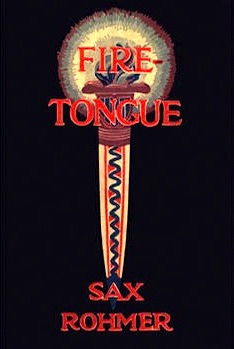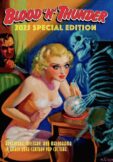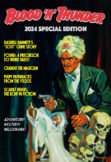EDitorial Comments
FIRE-TONGUE: Not So Hot.
For me, Sax Rohmer novels (along with those of Edgar Wallace, Erle Stanley Gardner, Edgar Rice Burroughs, and a half dozen other authors I could name) are the literary equivalents of comfort food: easy to digest, easy on the palate, and full of familiar flavor. Every now and then, though, I devour one that just doesn’t satisfy. Fire-Tongue (1921), which I recently consumed, actually left a bad taste in my mouth.
Published in England by Cassells and serialized here in Collier’s prior to being issued in hard covers by Doubleday, Page & Company, Fire-Tongue continues the adventures of a minor Rohmer hero, London-based private investigator Paul Harley, whom we’re told has had considerable success solving bizarre crimes and is “the last court of appeal to which Home Office and Foreign Office alike came in troubled times.” In other words, he’s Nayland Smith without the earlobe-tugging and nervous energy.
As the story opens Harley is visited in his Chancery Lane office by Sir Charles Abingdon, a prominent surgeon whose background includes a lengthy stint in the Orient. He tells the detective that his life is in danger but, characteristically for a Rohmer novel, seems curiously unwilling to unburden himself fully at the outset. Nonetheless, Harley agrees to help and promises to join Sir Charles at home that evening for a full explanation.
Abingdon is convinced that he’s being watched and followed constantly, and the investigator gets the same feeling as he approaches the surgeon’s residence. Rohmer explains that Harley has a sixth sense, which alerts him to the presence of potential danger: “It was an evasive, fickle thing, but was nevertheless the attribute which had made him an investigator of genius.”
There’s more beating around the bush when Sir Charles welcomes Harley into his home—which, not unexpectedly, is furnished in Oriental style. (One can be forgiven for believing that all Rohmer characters patronize the same curio shop.) Later, without having explained much at all, the surgeon has some sort of seizure and collapses. His last words are “Fire-Tongue…Nicol Brinn.”
Twenty-seven pages into the novel, we don’t know a whole lot more than we did at the beginning. Abingdon has a beautiful daughter named Phyllis (referred to throughout the yarn, somewhat annoyingly, as “Phil”), who enjoys the friendship of a handsome Persian named Ormuz Khan. Sir Charles distrusted this man, perhaps owing to a conviction that his recent problems and general unease had their origins in the East.
Nicol Brinn proves to be a charismatic American adventurer with a tragic secret, well known for having courted and cheated death repeatedly with a series of sensational exploits. He, too, has had strange experiences in the East and shares Abingdon’s reluctance to reveal anything that could help clear up the mystery of the surgeon’s sudden death, eventually revealed as the by-product of a subtle, cleverly administered poison.
Following the death of Sir Charles, nothing of significance occurs in Fire-Tongue for more than a hundred pages. Rohmer serves up plenty of atmospherics but few characters and little plot development. Halfway through the 304-page Doubleday edition I got the distinct impression that he began the story with little or no idea where it was headed, that he made it up as he went along. Even though Paul Harley has been established as the protagonist, it’s Nicol Brinn who comes to dominate the story.
 Not surprisingly, this “Fire-Tongue” is our friend Ormuz Khan, who secretly heads an Oriental cult determined to unite the forces of the East and wreak havoc on the West. But he’s a singularly ineffectual menace: Aside from capturing Phyllis Abingdon and Paul Harley (whose vaunted intuition fails him miserably), Fire-Tongue utterly fails to accomplish anything worthy of note. Brinn’s tragic secret turns out to be his love for the novel’s femme fatale, Naida, who is dispatched without prejudice by Ormuz Khan once he learns she’s been playing footsie with the American.
Not surprisingly, this “Fire-Tongue” is our friend Ormuz Khan, who secretly heads an Oriental cult determined to unite the forces of the East and wreak havoc on the West. But he’s a singularly ineffectual menace: Aside from capturing Phyllis Abingdon and Paul Harley (whose vaunted intuition fails him miserably), Fire-Tongue utterly fails to accomplish anything worthy of note. Brinn’s tragic secret turns out to be his love for the novel’s femme fatale, Naida, who is dispatched without prejudice by Ormuz Khan once he learns she’s been playing footsie with the American.
In a brief, perfunctory, and wholly disappointing climax, Fire-Tongue abandons his headquarters and is hotly pursued by Harley and Brinn, who crash their car into his. The big chase lasts all of two short paragraphs. Ormuz Khan is killed in the crack-up and Harley is taken to hospital with minor injuries.
The novel’s last 36 pages—more than a tenth of its total wordage—are devoted to a laborious explanation by Nicol Brinn of Fire-Tongue’s origin and miraculous powers (which have amounted to little more than an ability to produce flame at will—a simple magic trick). The American adventurer, we learn, used his well-publicized trip to Tibet as an excuse to search for the fabled Temple of Fire—where, according to ancient prophesy, a second Zoroaster was about to appear to “redeem and revolutionize the world” and “preach the doctrine of eternal fire.” Brinn found the place, learned that Ormuz Khan had set himself up as the Master, and fell in love with Naida, one of Fire-Tongue’s followers.
In this novel Rohmer gives the reader a big build-up but lets him down badly. Put succinctly, the yarn lacks punch. The enigmatic Fire-Tongue and his followers are, quite unintentionally I’m sure, revealed as bunglers; my sense was that the whole bunch wouldn’t have lasted a single round in the ring with one of Fu Manchu’s dacoits. And the sublimely intuitive Paul Harley reminds me of Hallorann, the old caretaker played by Scatman Crothers in the movie version of Stephen King’s The Shining. Remember him? Hallorann has the psychic ability to “see” things unfolding hundreds of miles away, but he can’t tell that Jack Nicholson’s Torrance is waiting around the corner to bury an ax in his chest. Rohmer wastes hundreds, maybe thousands of words describing Harley’s sensitivity to dangerous surroundings and occult phenomena, but his ostensible protagonist is captured by Fire-Tongue’s minions with laughable ease, leaving a supporting character to perform the story’s nominal heroics. Phooey.
Bottom line: About the only thing Fire-Tongue did was burn me up.
Recent Posts
- Windy City Film Program: Day Two
- Windy City Pulp Show: Film Program
- Now Available: When Dracula Met Frankenstein
- Collectibles Section Update
- Mark Halegua (1953-2020), R.I.P.
Archives
- March 2023
- July 2021
- May 2021
- March 2020
- February 2020
- December 2019
- November 2019
- October 2019
- September 2019
- August 2019
- May 2019
- April 2019
- March 2019
- February 2019
- December 2018
- November 2018
- October 2018
- August 2018
- June 2018
- February 2018
- December 2017
- October 2017
- September 2017
- August 2017
- May 2017
- April 2017
- February 2017
- September 2016
- August 2016
- July 2016
- June 2016
- November 2015
- October 2015
- September 2015
- August 2015
- July 2015
- June 2015
- May 2015
- April 2015
- March 2015
- February 2015
- January 2015
- August 2014
- July 2014
- June 2014
- May 2014
- April 2014
- January 2014
- December 2013
- September 2013
- August 2013
- July 2013
- June 2013
- May 2013
- April 2013
- March 2013
- February 2013
- January 2013
- December 2012
- October 2012
- September 2012
- August 2012
- July 2012
- June 2012
- May 2012
Categories
- Birthday
- Blood 'n' Thunder
- Blood 'n' Thunder Presents
- Classic Pulp Reprints
- Collectibles For Sale
- Conventions
- Dime Novels
- Film Program
- Forgotten Classics of Pulp Fiction
- Movies
- Murania Press
- Pulp People
- PulpFest
- Pulps
- Reading Room
- Recently Read
- Serials
- Special Events
- Special Sale
- The Johnston McCulley Collection
- Uncategorized
- Upcoming Books
- Western Movies
- Windy City pulp convention
Dealers
Events
Publishers
Resources
- Coming Attractions
- Field Guide to Wild American Pulp Artists
- MagazineArt.Org
- Mystery*File
- ThePulp.Net




